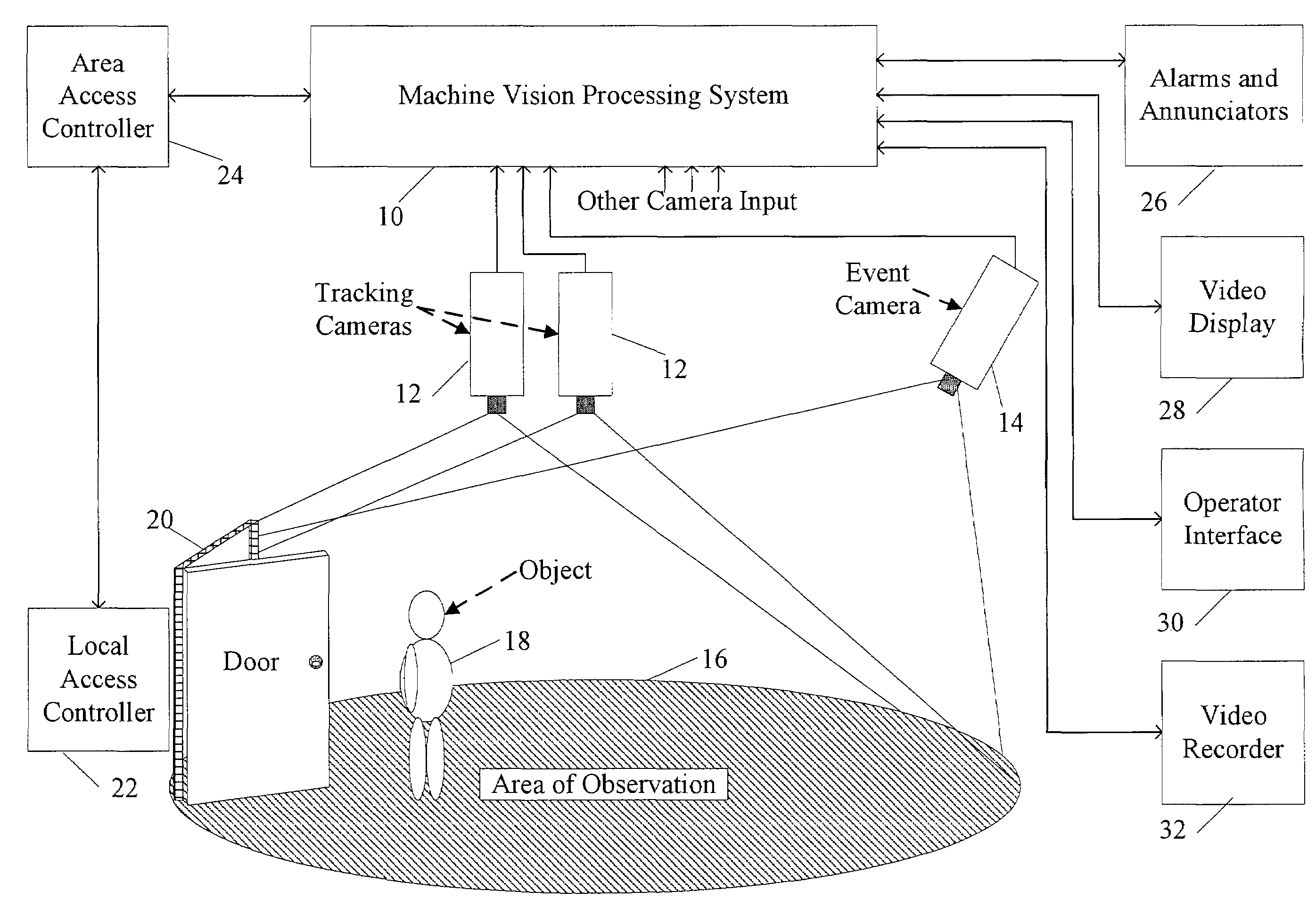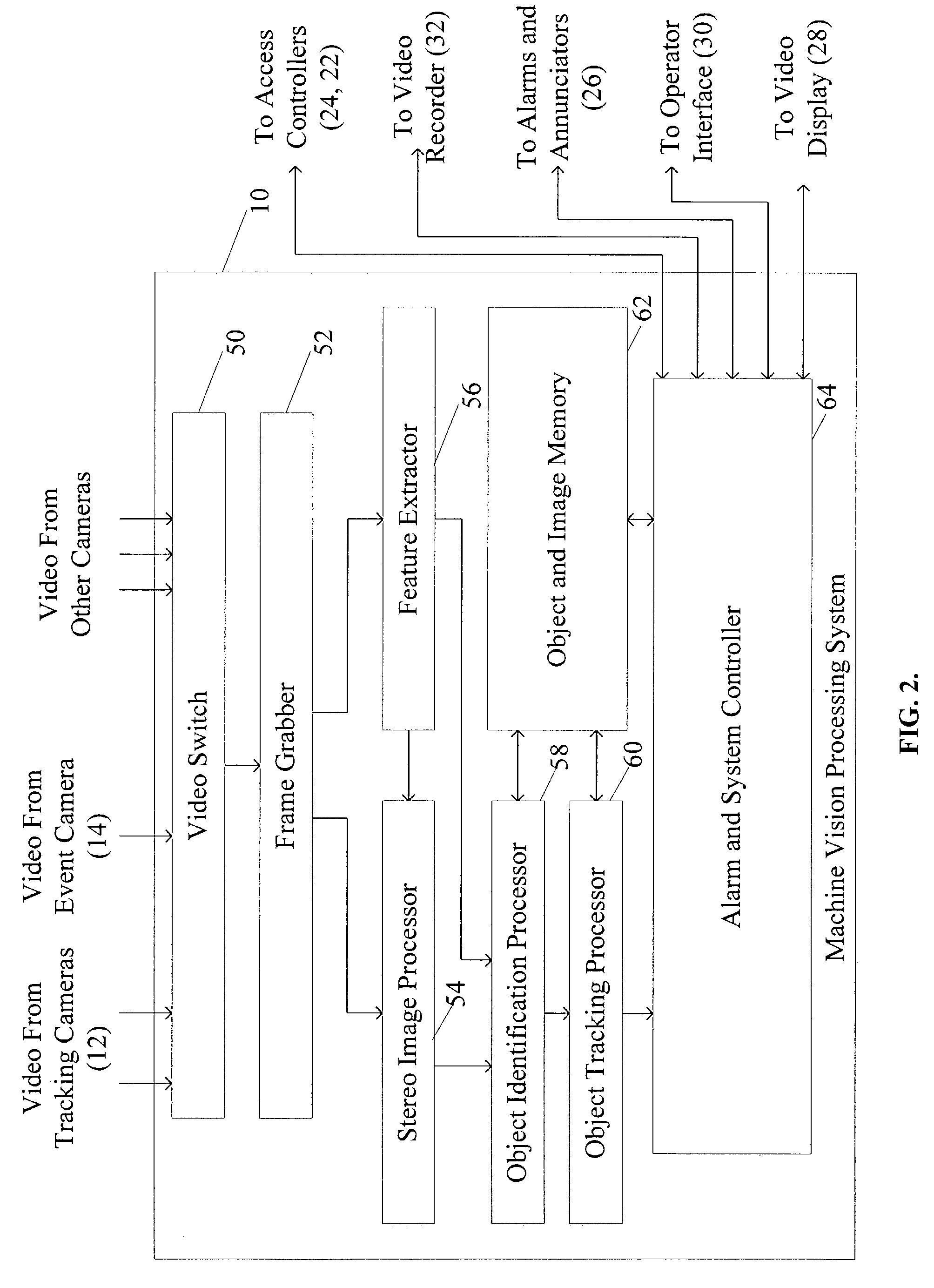Tailgating and reverse entry detection, alarm, recording and prevention using machine vision
a reverse entry and detection technology, applied in the field of detection, alarming, recording and prevention of unauthorized entry, can solve the problems of significant tailgating (also known as piggybacking), serious damage to property or harm to individuals in the controlled area, access control violation, etc., and achieve the effect of more reliable operation
- Summary
- Abstract
- Description
- Claims
- Application Information
AI Technical Summary
Benefits of technology
Problems solved by technology
Method used
Image
Examples
first embodiment
[0037]A first preferred embodiment of the invention uses a stereo pair of tracking cameras and a single event capture camera combined with machine vision processing to detect or prevent tailgating and / or reverse entry events.
Overview
[0038]A block diagram of the first embodiment of the invention is shown in FIG. 1. FIG. 1 depicts a machine vision processing system 10 that is capable of processing video images and detecting tailgating or reverse entry events. The machine vision processing system 10 receives video inputs from cameras, here a stereo pair of tracking cameras 12, and an event capture camera 14. Other camera inputs to the machine vision processing system 10 may be included if desired. The overlapping viewing area of these cameras is shown in FIG. 1 as an area of observation 16 in which objects 18 are identified, classified and possibly tracked by the machine vision processing system 10. Part of the area of observation 16 may optionally be defined by a door, gate, portal, e...
second embodiment
[0117]A second preferred embodiment operates in much the same manner as the first embodiment, which has already been described in detail. To reduce cost, the second embodiment uses a single camera in place of the stereo tracking camera pair 12 that is used in the first embodiment. This embodiment loses the benefits of stereoscopic image analysis and 3D surface analysis, but still can use other machine vision methods including, motion tracking, background differencing, image segmentation, texture analysis, and shape analysis. Alternatively, a gray scale (non-color) camera may be used as a further cost reduction, but losing the benefits of color analysis. These alternative embodiments retain all other functionality and scope of the first embodiment for detection and reporting of tailgating or reverse entry events.
third embodiment
[0118]A third preferred embodiment operates in much the same manner as the first embodiment, which has already been described in detail. To reduce cost, the third embodiment uses gray scale cameras in place of the color stereo tracking camera pair 12 and color event camera 14 used in the first embodiment. This embodiment loses the benefits of color analysis, but still uses machine vision methods, including stereoscopic image and 3D surface analysis, to classify and track objects and determine whether their presence and / or activity is authorized. In a further alternative, a gray scale (non-color) camera is used for the event camera 14 and color cameras are used for the stereo camera pair 12. This alternative retains the benefits of color analysis for the object identification and tracking capability, and only reduces the cost and capability of the event camera. These alternative embodiments retain all other functionality and scope of the first embodiment for detection and reporting o...
PUM
 Login to View More
Login to View More Abstract
Description
Claims
Application Information
 Login to View More
Login to View More - R&D
- Intellectual Property
- Life Sciences
- Materials
- Tech Scout
- Unparalleled Data Quality
- Higher Quality Content
- 60% Fewer Hallucinations
Browse by: Latest US Patents, China's latest patents, Technical Efficacy Thesaurus, Application Domain, Technology Topic, Popular Technical Reports.
© 2025 PatSnap. All rights reserved.Legal|Privacy policy|Modern Slavery Act Transparency Statement|Sitemap|About US| Contact US: help@patsnap.com



